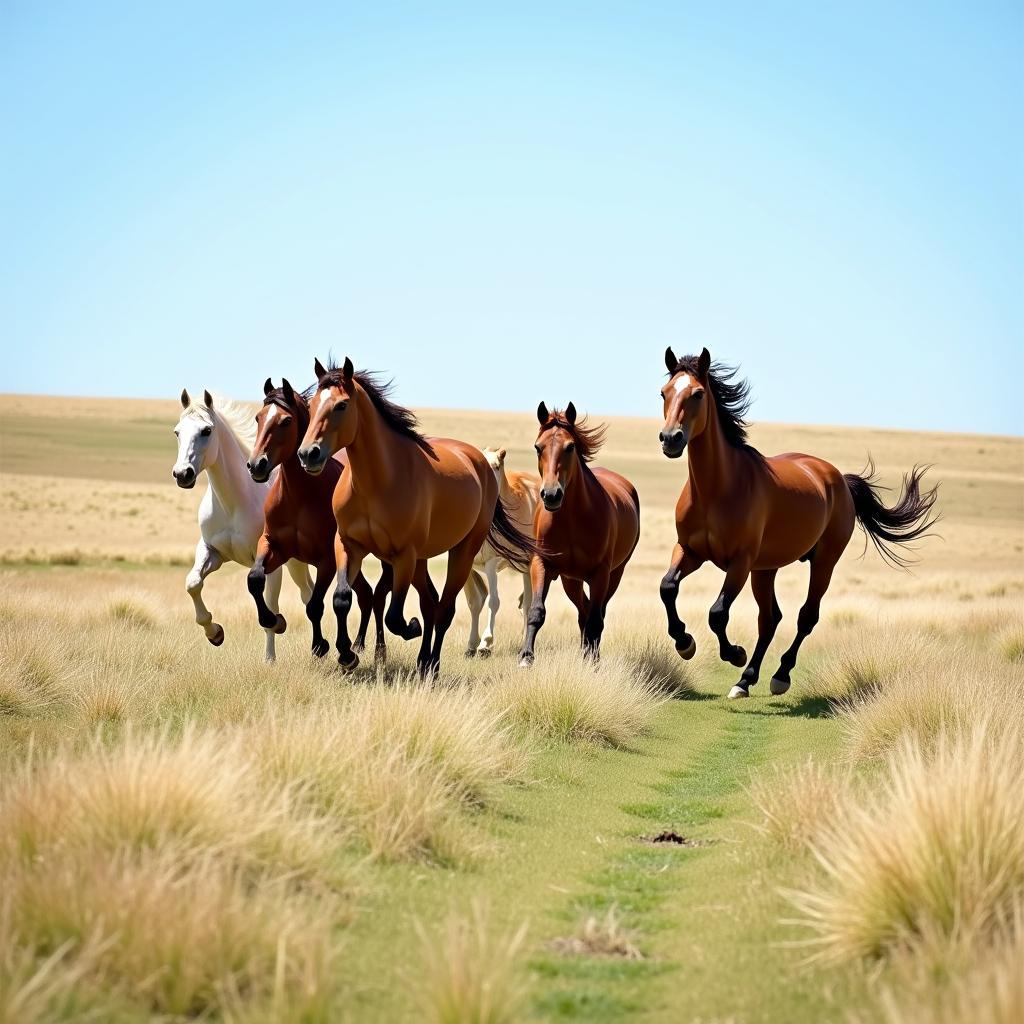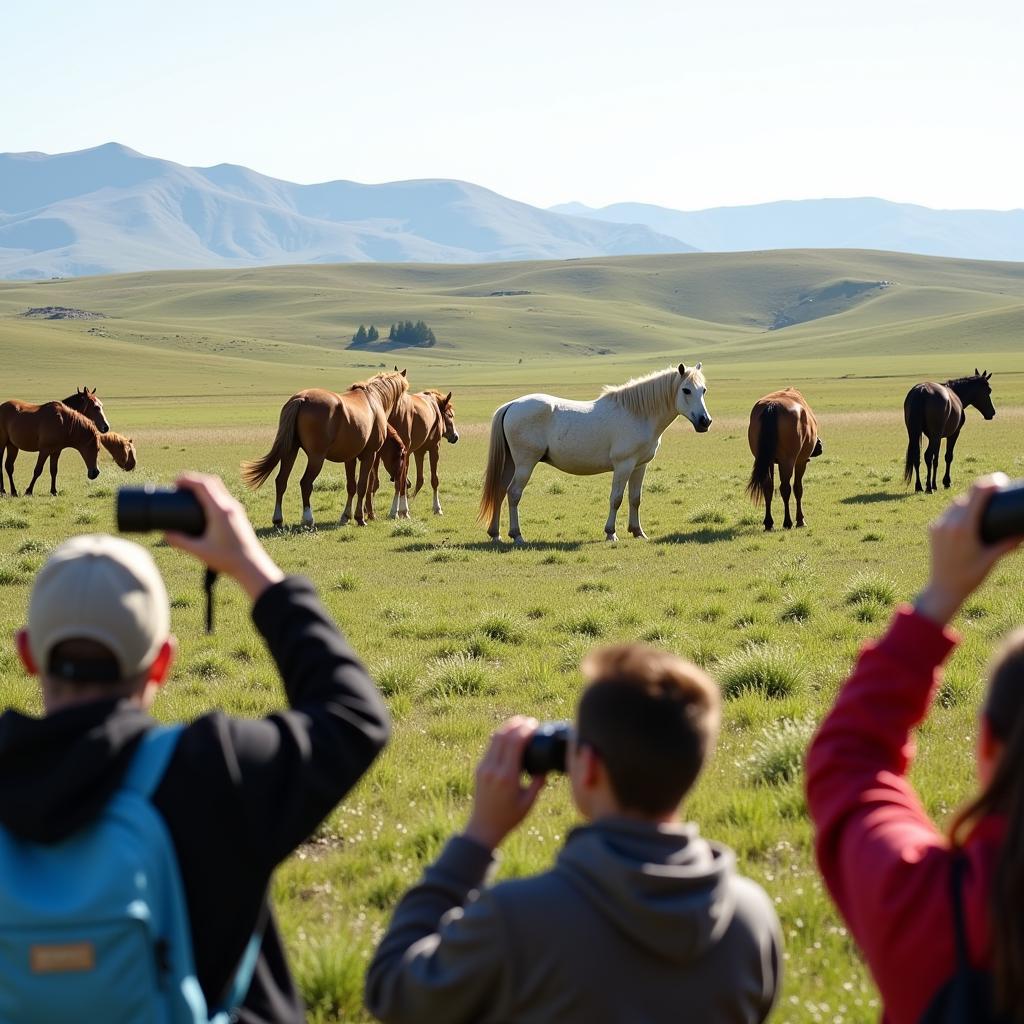Wild Horses In Kansas evoke images of untamed beauty and the spirit of the American West. These majestic creatures, descendants of Spanish Mustangs and other breeds, roam freely across select areas of the state, representing a living link to its rich history.  Wild horses galloping across the Kansas prairie
Wild horses galloping across the Kansas prairie
Discovering the Wild Horses of Kansas
Kansas, often referred to as the “heart of America,” provides a surprisingly diverse habitat for wild horses. While not native to the region, these horses have adapted and thrived, creating unique ecosystems. They inhabit areas characterized by rolling hills, grasslands, and open plains, finding sustenance in the native vegetation. Their presence contributes to the biodiversity of the state and serves as a testament to their resilience. Learning about their history, behavior, and the challenges they face is crucial to ensuring their continued survival.
Where can you find these magnificent creatures? Specific locations are often protected to minimize human interference, but with careful research and planning, you might be lucky enough to witness them in their natural habitat.  Observing wild horses in their natural Kansas habitat
Observing wild horses in their natural Kansas habitat
The History of Wild Horses in Kansas
The story of wild horses in Kansas is intertwined with the history of the state itself. From the arrival of Spanish explorers who brought horses to the Americas, to the introduction of other breeds by settlers, the equine population has evolved over centuries. Some horses escaped domestication, forming feral herds that eventually became the wild horses we see today. Understanding this historical context provides a deeper appreciation for their place in the Kansas landscape.
The Importance of Conservation Efforts
Wild horse populations face numerous challenges, including habitat loss, limited resources, and human encroachment. Conservation efforts are essential to protect these animals and ensure their long-term survival. Organizations dedicated to wild horse preservation work tirelessly to monitor herd health, manage populations, and educate the public about the importance of these magnificent creatures.
Where to See Wild Horses in Kansas
While the exact locations of wild horse herds are often kept confidential to protect them from disturbance, there are resources available to those interested in observing these animals responsibly. Contacting local conservation groups, wildlife agencies, or nature centers can provide valuable insights and guidance. dodge city to hays city by horse This adventure might just offer a glimpse of these magnificent creatures. Remember that respecting their space and observing them from a safe distance is crucial to minimizing human impact.
Respecting Wild Horses: A Guide for Observers
Observing wild horses is a privilege, and it’s essential to approach these encounters with respect and mindfulness. Avoid making sudden movements or loud noises that could startle them. Never attempt to feed or interact with the horses directly. By adhering to these guidelines, you can contribute to their well-being and ensure that future generations can continue to marvel at these symbols of freedom.
Understanding Wild Horse Behavior
Wild horses exhibit fascinating social behaviors and dynamics within their herds. They have complex communication systems, using vocalizations, body language, and scent to interact with one another. Understanding these behaviors can enhance your appreciation for their intelligence and adaptability.
“Observing the intricate social structures within wild horse herds is truly captivating,” shares renowned equine behaviorist Dr. Sarah Mitchell. “Their communication methods and the bonds they form within the herd are remarkable examples of animal intelligence.”
The Future of Wild Horses in Kansas
Protecting wild horses for future generations requires ongoing commitment and collaborative efforts. Supporting conservation organizations, advocating for responsible land management practices, and educating others about the importance of these animals are crucial steps. “The legacy of wild horses in Kansas is a shared responsibility,” emphasizes Dr. Emily Carter, a wildlife conservation specialist. “By working together, we can ensure that these magnificent creatures continue to roam free for years to come.”
Can you help preserve this legacy? Even small actions can make a difference. can you bet on horse racing in kansas Learning about the challenges these horses face is a first step towards contributing to their conservation.
Conclusion
Wild horses in Kansas represent a vital part of the state’s natural and cultural heritage. By understanding their history, behavior, and the challenges they face, we can work together to protect these magnificent animals and ensure their continued presence in the heart of America.
FAQ
- Are wild horses native to Kansas? No, they are descendants of domesticated horses that escaped and formed feral herds.
- Where can I see wild horses in Kansas? Contact local conservation groups or wildlife agencies for responsible viewing opportunities.
- What are the threats to wild horses in Kansas? Habitat loss, limited resources, and human encroachment are major threats.
- How can I help protect wild horses? Support conservation organizations, advocate for responsible land management, and educate others.
- What should I do if I encounter wild horses? Observe them from a safe distance, avoid sudden movements and loud noises, and never attempt to feed or interact with them directly.
- What are some interesting behaviors of wild horses? They have complex communication systems and intricate social structures within their herds.
- What is the future of wild horses in Kansas? Ongoing conservation efforts and public awareness are crucial for their long-term survival.
When you need assistance, please contact us by Phone: 0772127271, Email: [email protected] or visit us at QGM2+WX2, Vị Trung, Vị Thuỷ, Hậu Giang, Việt Nam. We have a 24/7 customer service team.